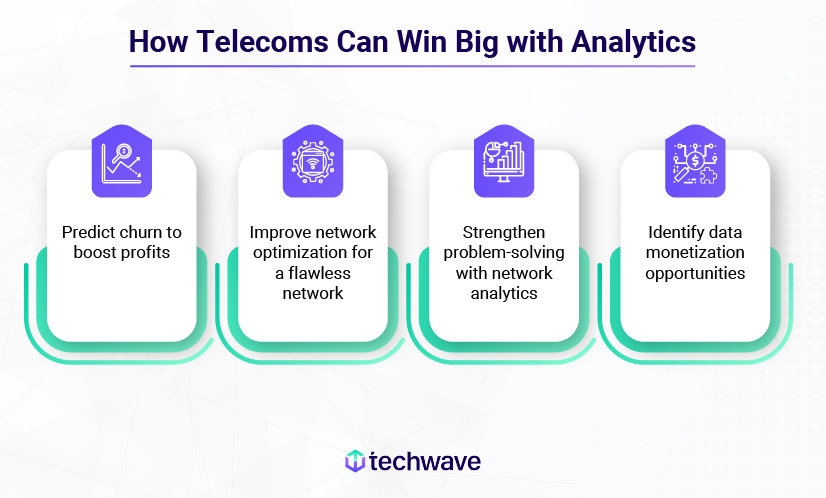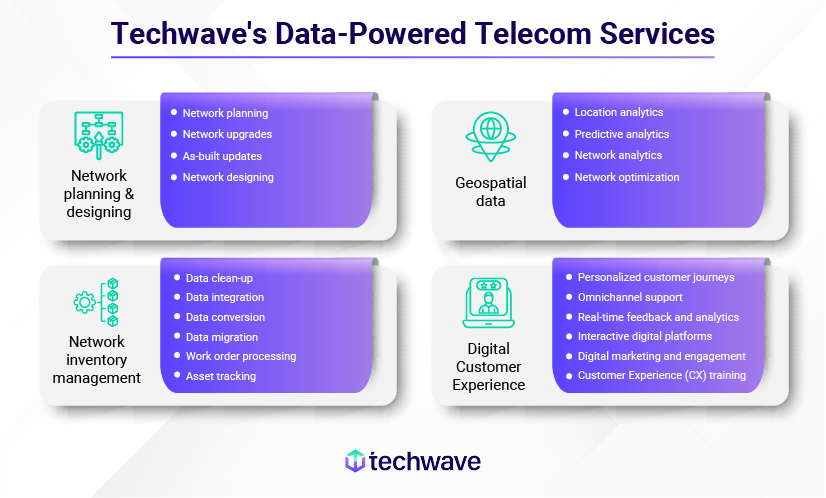
Scenario #1: Your subscriber relaxing at home when a work email hits inbox requiring them to finish a last-minute task and send. Between data depletion and struggling to find an alternative network, your subscriber might just lose a critical deadline. Panic sets in!
But what if you, the Data Provider, could prevent this entirely?
Powered by advanced data analytics, you can anticipate this exact scenario. Your system identifies subscribers nearing data depletion and approaching a known high-usage event (like a monthly payment due date).
Here’s where you take control and turn panic into delight!
Scenario #2: The subscriber receives a proactive notification offering a temporary data boost, just enough to complete the transaction. Crisis averted, and your customer feels valued and understood.
In today’s fast-paced telecom world, customer service is the secret weapon. Trends shift, and what customers crave isn’t just the latest phone but also a seamless, quality experience in it.
Research shows that customer-centric companies see a 25% loyalty jump and a 20% confidence boost. 81% of customers crave personalization, demanding brands “get to know them”. If you, too, are on the journey to improve your customer loyalty KPIs, this is your call to action—tailor interactions and build relationships.
Happy customers are loyal, and drive revenue growth. However, the constant data flow from smartphones and connected devices creates a data deluge – a treasure chest of user behavior, but also information overload.
What if companies could unlock this data’s secrets and understand how it drives growth? Telecom data analytics holds the key. Studies show telecom operators can increase revenue by 10% and enhance customer satisfaction by 20-30% through data-driven Customer Value Management (CVM). Plus, the rise of remote and hybrid work has fueled a surge in demand for telecom services , highlighting the market’s significant growth.
Hence, telecom companies must prioritize building lasting data and customer experiences. The earlier example shows precisely this—how big data analytics can predict needs and proactively offer solutions, creating a seamless experience that fosters loyalty and satisfaction. This is how you win in telecom today.
Data Analytics: The key to improving customer experiences in telecom
Globally, average mobile data usage per smartphone is poised for a triple-digit surge —jumping from 21 GB in 2023 to a whopping 56 GB by 2029. That’s every interaction, click, and call generating a mountain of information—”Big Data”—often overwhelming and challenging to analyze with traditional methods.
The comprehensive set of data that telecom companies gather can be categorized as:
- Network performance data: Traffic volume, bandwidth usage, latency (signal delay), and fault detection, providing a real-time picture of network health.
- Call detail records (CDRs): Document the who, what, when, and where of every call—phone numbers, durations, timestamps, and even location data.
- Customer data: Demographics, profiles, preferences, purchase history, and support interactions, offering a holistic view of each customer.
- Call center interactions: Data captured during customer interactions with the telecom provider’s call center include the reason for the call, the call duration, any notes or transcripts from the conversation, and the resolution achieved.
- User Feedback: Data from app store reviews, such as star ratings and comments; social media channels that reveal public perception and trends through mentions, sentiment analysis, and engagement metrics; and brand and user communities that offer insights from forums, polls, and support requests.
- Tower logs: Logs generated by cell towers in the network contain data about the devices connecting to the tower, including phone numbers, signal strength, data usage, and potentially cell handover details (when a device switches between towers).
A significant portion of this remains untapped due to limitations in processing and analysis. This translates to missed opportunities, such as inaccessible data hindering effective customer service, breeding mistrust, and fueling dissatisfaction. Ultimately, it impacts a company’s bottom line and reputation.
In response to these challenges, big data analytics is playing a growing role in optimizing and transforming the telecom industry. Gartner predicts, by 2026, a significant portion—over a quarter of Fortune 500 Chief Data and Analytics Officers (CDAOs)—will be responsible for at least one top-earning data and analytics product. This shift reflects the growing importance of data-driven analytics across businesses.
However, telecom user analytics goes beyond basic numbers. It harnesses vast data from networks, operations, and applications to reveal customer behavior, network performance, and potential issues. Traditionally, this helped companies react. Now, AI and Machine Learning (ML) unlock a new level of proactive insights, predicting future trends and customer needs.
In short, user experience takes center stage. Telcos can use data analytics to not only grow their business but also prioritize user behavior. This means anticipating customer needs and offering solutions before problems arise.
Ready to transform your business and become a data-driven leader? Let’s explore how telcos can leverage data analytics to become customer experience leaders and accelerate business growth.

1. Predict churn before it happens.
Imagine boosting profits by 25-95% just by keeping customers happy! Stats show a 5% retention increase delivers this dramatic shift. Why? Acquiring new customers is expensive—marketing wars, fierce competition, etc. Keeping existing ones is cheaper and more rewarding.
However, telecoms face a formidable foe: customer churn, where happy subscribers become frustrated ex-customers. Slow networks, frustrating call centers, poor data speeds, and inaccurate billing are significant culprits.
The solution? Data-driven analytics. Think of it as a crystal ball that predicts which customers are at risk of leaving.
For example, faced with high churn, Verizon used data to fight back. Limited plans and a lack of engagement were driving away prepaid customers. Their solution? ‘Verizon Up’, a loyalty program rewarding refills and offering points redeemable for device discounts, data upgrades, or entertainment. Data analytics also help with:
- Targeted promotions: Offering discounts to incentivize plan upgrades
- Personalized communications: Reminding customers about expiring plans or suggesting relevant data packages based on their usage
The result? Lower churn among prepaid customers and higher Customer Lifetime Value (CLTV).
2. Improve network optimization.
Millions rely on telecoms for flawless connections. However, keeping up with their data demands is a constant challenge.
Network optimization is the answer. It rapidly analyzes vast amounts of real-time data (including data usage, network logs, mobility patterns, hardware challenges, and peak loads) to boost speeds and call quality, reduce buffering and dropped calls, and improve network coverage.
The result? A happier customer base. Combining Big Data and AI/ML equips telcos to achieve a new level of network optimization by:
- Optimizing the allocation of work and resources for a smooth experience for all
- Identifying congested areas for focused upgrades
- Diagnosing issues before they cause problems
- Fine-tuning routing for clear calls and a seamless online experience
It is a win-win for customers and telecom companies!
Ericsson’s Cognitive Software portfolio is a prime example of using AI to tackle the complexities of modern networks. It leverages big data to proactively identify and resolve Radio Access Network (RAN) issues across modern multi-technology and multi-layer networks.
3. Strengthen problem-solving with network analytics.
Network analytics delves into how telecom networks function, from towers to connections. Timing maintenance is crucial to avoid costly repairs.
However, telecom networks are complex and require constant maintenance. Juggling complex systems, preventing costly downtime, and staying ahead of equipment failures is challenging. Network analytics powered by big data and ML are changing the game. Also, cloud-based systems like Network Function Virtualization (NFV) and Software-defined Networking (SDN) are streamlining network management tasks like:
- Address activation and provisioning: Set up and manage services through an intuitive portal.
- Change management: Streamline changes with software for accuracy.
- Inventory management: Track network equipment meticulously.
- Performance optimization: Fine-tune settings based on real-time performance.
For instance, Deutsche Telekom, a European telecom giant, was grappling with a slow and expensive 5G rollout , primarily due to the inefficiencies of traditional methods. These included manual processes and drive-testing, which proved inaccurate and costly. To tackle these issues, Deutsche Telekom turned to Google Cloud.
Google Cloud’s data analytics expertise gave Deutsche Telekom deeper insights into its networks, aiding precise planning, streamlined operations, and improved customer experience management. The telecom giant plans to pilot use cases such as anomaly detection, performance counter analysis, and trace data utilization using Google Cloud’s open, Kubernetes-based solutions for data-driven operations and automated workflows.
4. Identify and enable data monetization opportunities.
By leveraging advanced analytics, telecom companies can generate valuable insights for various industries, enabling data monetization. This process involves two key steps:
- Optimizing billing, identifying revenue leakage, and enhancing the customer experience
- Mining, modeling, aggregating, and anonymizing these data sets
Data monetization turns data assets into revenue or strategic advantages.
For example, retailers can use telecom subscribers’ location data for customized promotions. Telecom companies often sell anonymized data to industries like healthcare, financial services, or advertising without violating users’ privacy. Large retailers like Amazon and Walmart leverage shopping habits data for tailored content. In short, big data analytics in telecom industry enables operators to monetize data while safeguarding privacy.
To identify revenue opportunities through data analysis, telecom operators can employ several strategies:
- Customer segmentation: Telecom providers with a growing customer base face the challenge of not being able to cater to unique needs. Customer segmentation can tackle this by grouping customers based on shared behaviors. This strategy allows telecom operators to:
⇒ Target high-value customers with exclusive offers, boosting loyalty and reducing churn.
⇒ Personalize offers that perfectly match each customer’s needs, leading to happier and more satisfied users.
⇒ Churn Predictions to identify potential issues, allowing you to focus your efforts where they’ll pay off most.
⇒ Discover new markets with high potential, letting you expand your reach and avoid wasting resources.
The benefits? Refined marketing strategies, stronger customer relationships, and ultimately growth in bottom line.
- Targeted marketing: Imagine marketing that works for everyone. Targeted marketing strategies deliver just that for telecom companies.
⇒ Budget optimization by focusing resources on high-value segments, maximizing return on investment.
⇒ Personalized offers and recommendations lead to a more satisfying customer experience, fostering loyalty and repeat business.
⇒ Data-driven targeting that leverages customer data to target relevant offerings, resolve issues, and boost satisfaction.
⇒ Location-based insights to analyze geospatial information to understand customer preferences and behavior.
Using targeted marketing, telecom companies can achieve a win-win situation – increased revenue and happier customers.
- Fraud detection: According to the Communications Fraud Control Association (CFCA), the global industry lost an estimated $38.95 billion in 2023 due to fraud, a worrying 12% rise compared to 2021. Telecom fraud today is characterized by its invisibility and immediacy. Cybercriminals execute sophisticated scams across various regions, raking in millions of dollars and disappearing before providers even realize what’s happening.
Telcos can detect fraud activities using data analytics and machine learning algorithms. For example, data analytics can detect SIM swap fraud by comparing a user’s typical network activity with real-time activity. This can help identify suspicious changes, such as:
⇒ A sudden increase in data usage from a new location
⇒ Login attempts from a different device or location
- Price optimization: The telecom industry is a battleground for subscribers, and price is the biggest weapon. Here’s how big data helps telcos win:
⇒ Real-time insights to understand customer behavior and market trends.
⇒ Targeted pricing can be tested on various customer segments and locations.
⇒ Price optimization can help find the sweet spot – maximizing revenue without losing customers.
Big data gives telcos the edge in this competitive landscape, ensuring they offer the right price for the right customer at the right time.
Telecoms: Future-Proof Your Network with Techwave’s Data-driven & Customer-centric Services
Leverage the power of your data with Techwave, a leading global provider of digital transformation services . While Techwave delivers end-to-end network design expertise, our true value lies in being your one-stop partner for unlocking the power of data in the telecom transformation landscape. We offer a unique value proposition: deep industry knowledge plus cutting-edge data analytics, from design to deployment. Our experts bring a wealth of experience in telecom NOCs , field deployments, and IT applications.

Techwave goes beyond basic network solutions – we deliver a customized approach that optimizes your network performance and offers an unparalleled customer experience. Ready to explore the hidden value in your data? Partner with Techwave’s telecom experts.
